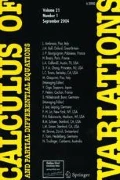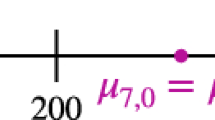Abstract
We present an analytical treatment of a three-dimensional variational model of a system that exhibits a second-order phase transition in the presence of dipolar interactions. Within the framework of Ginzburg–Landau theory, we concentrate on the case in which the domain occupied by the sample has the shape of a flat thin film and obtain a reduced two-dimensional, non-local variational model that describes the energetics of the system in terms of the order parameter averages across the film thickness. Namely, we show that the reduced two-dimensional model is in a certain sense asymptotically equivalent to the original three-dimensional model for small film thicknesses. Using this asymptotic equivalence, we analyze two different thin film limits for the full three-dimensional model via the methods of \(\Gamma \)-convergence applied to the reduced two-dimensional model. In the first regime, in which the film thickness vanishes while all other parameters remain fixed, we recover the local two-dimensional Ginzburg–Landau model. On the other hand, when the film thickness vanishes while the sample’s lateral dimensions diverge at the right rate, we show that the system exhibits a transition from homogeneous to spatially modulated global energy minimizers. We identify a sharp threshold for this transition.
Similar content being viewed by others
Notes
Recall that \(D + B_\delta = \mathbf \{ {\mathbf {r}} \in {\mathbb {R}}^2 : \text {dist}(\mathbf r, D) < \delta \}\).
References
Andelman, D., Broçhard, F., Joanny, J.F.: Phase transitions in Langmuir monolayers of polar molecules. J. Chem. Phys. 86, 3673–3681 (1987)
Andelman, D., Rosensweig, R.E.: Modulated phases: review and recent results. J. Phys. Chem. B. 113, 3785–3798 (2009)
Braides, A.: \(\Gamma \)-Convergence for Beginners, Volume 22 of Oxford Lecture Series in Mathematics and its Applications. Oxford University Press, Oxford (2002)
Braides, A., Truskinovsky, L.: Asymptotic expansions by \(\Gamma \)-convergence. Contin. Mech. Thermodyn. 20, 21–62 (2008)
Chikazumi, S.: Physics of Ferromagnetism. Oxford University Press, Oxford (2005)
Choksi, R., Kohn, R.V.: Bounds on the micromagnetic energy of a uniaxial ferromagnet. Comm. Pure Appl. Math. 51, 259–289 (1998)
Choksi, R., Kohn, R.V., Otto, F.: Domain branching in uniaxial ferromagnets: a scaling law for the minimum energy. Commun. Math. Phys. 201, 61–79 (1999)
De Masi, A., Orlandi, E., Presutti, E., Triolo, L.: Glauber evolution with the Kac potentials. I. Mesoscopic and macroscopic limits, interface dynamics. Nonlinearity. 7, 633–696 (1994)
DeSimone, A., Knüpfer, H., Otto, F.: 2-d stability of the Néel wall. Calc. Var. PDE. 27, 233–253 (2006)
DeSimone, A., Kohn, R.V., Müller, S., Otto, F.: Recent analytical developments in micromagnetics. In: Bertotti, G., Mayergoyz, I.D. (eds.) The Science of Hysteresis, Volume 2 of Physical Modelling, Micromagnetics, and Magnetization Dynamics, Academic Press, Oxford (2006)
Di Nezza, E., Palatucci, G., Valdinoci, E.: Hitchhiker’s guide to the fractional Sobolev spaces. Bull. Sci. Math. 136, 521–573 (2012)
Evans, L.C., Gariepy, R.L.: Measure Theory and Fine Properties of Functions. Routledge, Boca Raton (2015)
Garel, T., Doniach, S.: Phase transitions with spontaneous modulations-the dipolar Ising ferromagnet. Phys. Rev. B. 26, 325–329 (1982)
Gilbarg, D., Trudinger, N.S.: Elliptic Partial Differential Equations of Second Order. Springer, Berlin (1983)
Gioia, G., James, R.D.: Micromagnetics of very thin films. Proc. R. Soc. Lond. Ser. A. 453, 213–223 (1997)
Hohenberg, P.C., Krekhov, A.P.: An introduction to the Ginzburg–Landau theory of phase transitions and nonequilibrium patterns. Phys. Rep. 572, 1–42 (2015)
Hubert, A., Schäfer, R.: Magnetic Domains. Springer, Berlin (1998)
Jagla, E.A.: Numerical simulations of two-dimensional magnetic domain patterns. Phys. Rev. E. 70, 046204 (2004)
Kaplan, B., Gehring, G.A.: The domain structure in ultrathin magnetic films. J. Magn. Magn. Mater. 128, 111–116 (1993)
Knüpfer, H., Muratov, C.B.: Domain structure of bulk ferromagnetic crystals in applied fields near saturation. J. Nonlinear Sci. 21, 921–962 (2011)
Knüpfer, H., Muratov, C.B., Nolte, F.: Magnetic domains in thin ferromagnetic films with strong perpendicular anisotropy. Arch. Rat. Mech. Anal. (2018) (to appear)
Kohn, R.V., Slastikov, V.V.: Another thin-film limit of micromagnetics. Arch. Ration. Mech. Anal. 178, 227–245 (2005)
Landau, L.D., Lifshitz, E.M.: Course of Theoretical Physics. Pergamon Press, London (1984)
Lieb, E.H., Loss, M.: Analysis. American Mathematical Society, Providence (2010)
Lu, J., Moroz, V., Muratov, C.B.: Orbital free density functional theory of out-of-plane charge screening in graphene. J. Nonlinear Sci. 25, 1391–1430 (2015)
Malozemoff, A.P., Slonczewski, J.C.: Magnetic Domain Walls in Bubble Materials. Academic Press, New York (1979)
Modica, L.: The gradient theory of phase transitions and the minimal interface criterion. Arch. Rational Mech. Anal. 98, 123–142 (1987)
Mourrat, J.-C., Weber, H.: Convergence of the two-dimensional dynamic ising-kac model to \(\Phi ^4_2\). Comm. Pure Appl. Math. (2016) (published online)
Muratov, C.B.: Theory of domain patterns in systems with long-range interactions of Coulombic type. Ph. D. thesis, Boston University (1998)
Muratov, C.B.: Theory of domain patterns in systems with long-range interactions of Coulomb type. Phys. Rev. E. 66(066108), 1–25 (2002)
Muratov, C.B.: Droplet phases in non-local Ginzburg–Landau models with Coulomb repulsion in two dimensions. Comm. Math. Phys. 299, 45–87 (2010)
Muratov, C.B., Osipov, V.V., Vanden-Eijnden, E.: Persistence of magnetization configurations against thermal noise in thin ferromagnetic nanorings with four-fold magnetocrystalline anisotropy. J. Appl. Phys. 117, 17D118 (2015)
Ng, K.-O., Vanderbilt, D.: Stability of periodic domain structures in a two-dimensional dipolar model. Phys. Rev. B. 52, 2177–2183 (1995)
Otto, F., Viehmann, T.: Domain branching in uniaxial ferromagnets: asymptotic behavior of the energy. Calc. Var. Partial Differ. Equ. 38, 135–181 (2010)
Roland, C., Desai, R.C.: Kinetics of quenched systems with long-range repulsive interactions. Phys. Rev. B. 42, 6658–6669 (1990)
Rosensweig, R.E.: Ferrohydrodynamics. Courier Dover Publications, New York (1997)
Seul, M., Andelman, D.: Domain shapes and patterns: the phenomenology of modulated phases. Science. 267, 476–483 (1995)
Strukov, B.A., Levanyuk, A.P.: Ferroelectric Phenomena in Crystals: Physical Foundations. Springer, New York (1998)
Acknowledgements
This work was supported, in part, by NSF via Grants DMS-1313687 and DMS-1614948. The author would like to thank V. Slastikov for many valuable comments.
Author information
Authors and Affiliations
Corresponding author
Additional information
Communicated by A.Malchiodi.
Dedicated to V. V. Osipov on the occasion of his 77th birthday.
Publisher's Note
Springer Nature remains neutral with regard to jurisdictional claims in published maps and institutional affiliations.
Rights and permissions
About this article
Cite this article
Muratov, C.B. A universal thin film model for Ginzburg–Landau energy with dipolar interaction. Calc. Var. 58, 52 (2019). https://doi.org/10.1007/s00526-019-1493-4
Received:
Accepted:
Published:
DOI: https://doi.org/10.1007/s00526-019-1493-4



